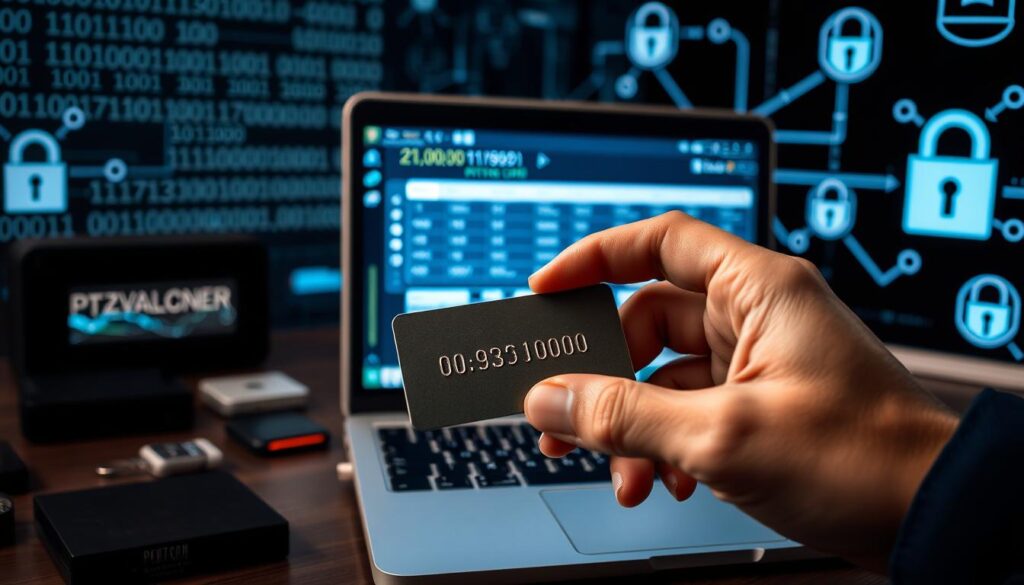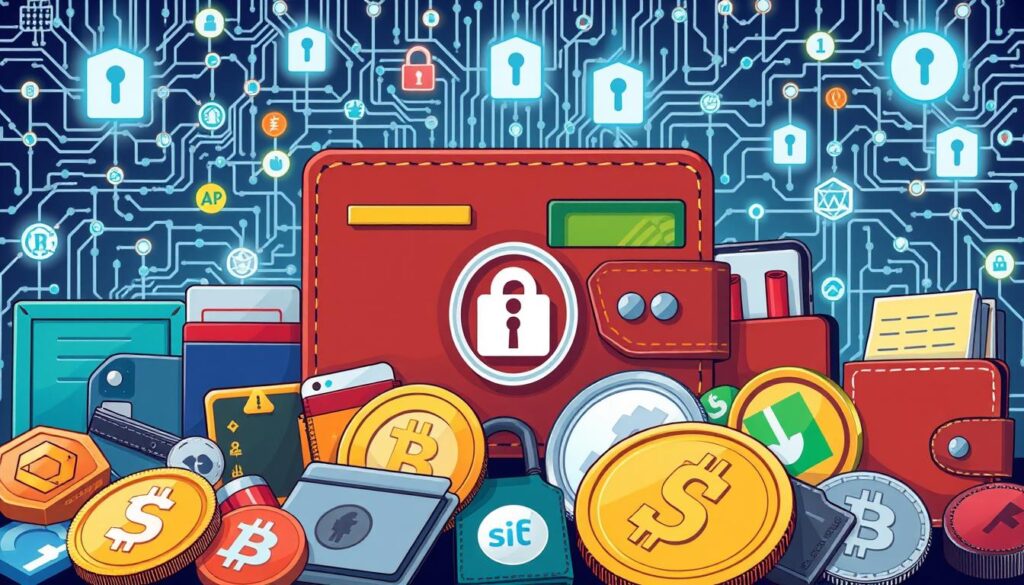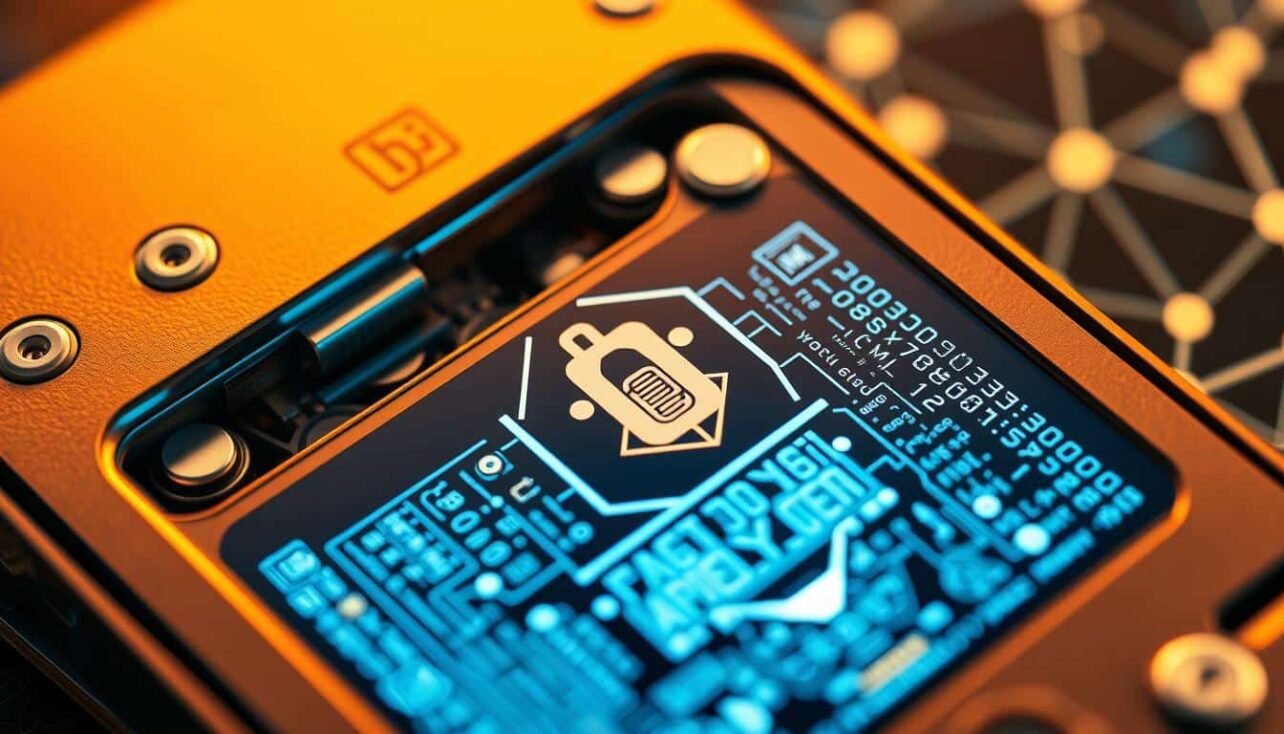A digital tool for managing blockchain-based assets has become vital in today’s financial landscape. These tools don’t hold physical currency but instead store unique codes required to access and transfer funds on decentralized networks. The first version was created by Bitcoin’s anonymous founder, followed closely by an early developer who tested its functionality.
As cyber risks grow more complex, protective measures for these systems have advanced significantly. Modern solutions now combine encryption, multi-layered verification, and offline storage to counter hacking attempts. This evolution ensures users can safely interact with blockchain platforms without compromising their holdings.
Understanding how these defenses work is critical for anyone involved with digital currencies. Whether you’re trading occasionally or managing large portfolios, weak safeguards could lead to irreversible losses. This guide breaks down core principles, from basic operations to cutting-edge protocols.
We’ll explore why certain methods outperform others and how to choose the right approach for your needs. By the end, you’ll know how to prioritize safety while navigating the fast-paced world of decentralized finance.
Key Takeaways
- Digital asset managers rely on encrypted keys instead of physical storage.
- Early versions paved the way for today’s advanced protective systems.
- Multi-step verification and offline options reduce exposure to online threats.
- User knowledge directly impacts the safety of blockchain transactions.
- This guide covers varied solutions tailored to different risk levels.
Understanding Cryptocurrency Wallets Overview
Accessing decentralized funds relies on applications that handle cryptographic data. These tools act as gateways to blockchain networks, letting you view balances and send transactions. Instead of holding actual coins, they track entries linked to your public address across the distributed ledger.
Definition and Basic Functionality
Think of these apps as personal dashboards for your blockchain activities. They generate and store private keys—secret codes proving ownership of digital assets. When you initiate a transfer, the software signs it with your key, broadcasting the transaction to the network.
Public keys act like email addresses for receiving funds, while private keys function as passwords. This system ensures only authorized users can move assets tied to their accounts. Modern interfaces hide this complexity, displaying simple send/receive buttons instead of raw code.
Hot Wallets versus Cold Wallets
Online-connected options (hot) offer instant access for frequent trading. Mobile and desktop apps fall into this category. Offline storage (cold) keeps keys isolated from internet threats—ideal for long-term holdings. Hardware devices like USB drives exemplify this approach.
Each method balances convenience and protection. Daily spending might use hot storage, while savings remain in cold systems. Understanding this split helps tailor your strategy to specific needs.
Essentials of Cryptocurrency Wallet Security Technology Features
At the heart of blockchain asset management lies a combination of encryption and access protocols. These systems rely on specialized methods to shield sensitive information from unauthorized access while enabling seamless transactions. Let’s break down their critical elements.

Core Components and Protection Measures
Modern solutions use three pillars to safeguard holdings: advanced encryption, multi-factor verification, and isolated storage environments. Encryption scrambles data into unreadable formats, requiring unique digital “keys” to decode. Multi-factor checks add extra confirmation steps before approving transfers.
| Component | Function | Benefit |
|---|---|---|
| 256-bit Encryption | Scrambles sensitive data | Prevents brute-force attacks |
| Biometric Verification | Requires fingerprint/face scan | Blocks unauthorized logins |
| Air-Gapped Storage | Keeps data offline | Eliminates remote hacking risks |
The Role of Private Keys
Your secure digital asset management system depends on private keys—digital signatures that prove ownership. These codes are mathematically linked to public addresses but remain hidden. Losing them means permanent loss of access, as there’s no central authority to recover accounts.
Advanced systems now generate keys in isolated environments, never exposing them to internet-connected devices. This approach stops malware from intercepting sensitive data during transactions. Always store backup codes physically, like engraved metal plates, to avoid digital corruption.
Types of Crypto Wallets and Their Security Measures
Managing digital assets requires choosing storage solutions that balance control and accessibility. Two primary categories exist: custodial and noncustodial systems. Each offers distinct advantages and trade-offs in asset protection.

Custodial versus Noncustodial Options
Custodial options let third parties manage your access codes, similar to traditional banks holding your funds. These services handle recovery if you lose login details but retain authority over transactions. Popular exchanges often use this model for user convenience.
Noncustodial systems put you in full charge of your access codes. While this eliminates reliance on intermediaries, it demands strict personal responsibility. Losing these codes means permanent asset loss with no recovery options.
| Type | Key Benefit | Main Risk |
|---|---|---|
| Custodial | Easy account recovery | Third-party breaches |
| Noncustodial | Full asset control | User error consequences |
Software, Hardware, and Paper Wallets
Online-based software tools provide quick access through apps or browsers. These “hot” systems work well for frequent transactions but face higher hacking risks. Regular updates and antivirus protection are essential.
Hardware devices store codes offline in physical gadgets resembling USB drives. They require manual confirmation for transactions, blocking remote attacks. Many support multiple blockchain networks.
Paper versions print access codes as QR or text for cold storage. While immune to digital threats, they demand careful physical protection from damage or loss. Laminating and using fireproof safes extends their lifespan.
For deeper insights into these systems, explore different options to match your risk tolerance and usage patterns.
Importance of Hardware Wallets for Maximum Protection
Physical devices that isolate sensitive data from online threats have transformed how users safeguard digital assets. Unlike internet-connected options, these tools maintain airtight barriers against remote attacks while enabling controlled access to blockchain networks.

Offline Storage and Encryption Benefits
Cold storage solutions excel by keeping access codes completely disconnected from web-based risks. This design eliminates vulnerabilities like phishing scams or malware that target software alternatives. Transactions require manual approval through built-in buttons, ensuring no unauthorized transfers occur.
Advanced systems integrate military-grade encryption chips to protect codes even if devices are physically compromised. These tamper-resistant components automatically erase data after multiple failed access attempts. Pair this with automatic firmware updates, and you get evolving defenses against emerging threats.
- Complete isolation from internet exposure
- Transaction verification through physical interaction
- Self-destruct mechanisms for intrusion detection
Recovery phrases provide a lifeline if devices get lost or damaged. Store these 12-24 word backups in fireproof containers or safety deposit boxes. Never digitize them—handwritten copies avoid cloud storage risks.
| Feature | Protection Level | User Action Required |
|---|---|---|
| Air-Gapped Design | High | None |
| Secure Element Chip | Maximum | PIN entry |
| Seed Phrase Backup | Critical | Physical storage |
Software Wallets: Balancing Convenience and Security
For everyday transactions, digital asset holders often turn to software-based solutions that prioritize speed and accessibility. These apps live on internet-connected devices, enabling instant transfers and real-time balance checks. Unlike offline storage methods, they’re designed for frequent use—paying bills, shopping online, or trading assets.
Desktop versions encrypt data locally, requiring passwords or PINs to unlock accounts. Advanced systems use secure communication protocols to shield transaction details during network transmission. Mobile apps take this further by integrating fingerprint scans and facial recognition, leveraging smartphone hardware for added protection.
Popular features driving adoption include:
- One-tap NFC payments at retail locations
- QR code scanning for instant address sharing
- Direct links to trading platforms and exchanges
Connected systems face unique risks. Malware targeting login credentials remains a top concern. Phishing scams mimicking legitimate apps can trick unsuspecting individuals into sharing sensitive data. Device theft also poses challenges if backups aren’t properly secured.
Mitigation strategies include:
- Installing updates promptly to patch vulnerabilities
- Using antivirus software on all devices
- Enabling multi-step verification for account access
While no system is foolproof, combining these practices with cautious browsing habits significantly reduces exposure. Choose apps with open-source code audits and avoid storing large sums in always-online accounts.
Paper Wallets and Offline Storage Solutions
In an era dominated by digital vulnerabilities, physical documentation of access codes offers a unique defense strategy. Paper-based systems provide airtight isolation from online threats by storing critical information in tangible formats. This approach removes all exposure to network-based attacks but introduces new challenges in physical preservation.

Creating Secure Paper Wallets
Generating reliable offline storage starts with specialized software that operates without internet connectivity. Tools like BitAddress allow users to create QR codes and alphanumeric strings on disconnected devices, preventing remote interception. Always use a freshly installed operating system and avoid printers with memory storage capabilities.
Key generation best practices include:
- Using a dedicated offline computer for code creation
- Disabling wireless connectivity during the process
- Verifying printer security (no cloud-connected devices)
Once printed, protect these documents from environmental hazards. Laminating sheets prevents smudging, while fireproof containers guard against accidents. Consider splitting codes across multiple locations to minimize theft risks.
| Protection Method | Advantage | Limitation |
|---|---|---|
| Safety Deposit Box | Bank-level physical security | Limited access during emergencies |
| Home Safe | Immediate availability | Vulnerable to natural disasters |
| Geographic Distribution | Reduces single-point failure | Increases retrieval complexity |
While offering unmatched resistance to cyberattacks, paper systems demand meticulous handling. Moisture, sunlight, and simple misplacement can permanently erase access. Regular condition checks and redundant backups are essential for long-term reliability.
Mobile Wallets: Security Tips for On-the-Go Use
Smartphone-based management of digital assets demands tailored protection strategies. These tools combine accessibility with unique risks, requiring users to adapt their safety habits for smaller screens and mobile networks. Let’s explore practical methods to keep your funds secure while managing them from anywhere.
Biometric Locks and Access Codes
Modern smartphones offer fingerprint scanners and facial recognition systems that add speed to verification processes. Pair these with 12-character passwords mixing uppercase letters, symbols, and numbers. Avoid repeating codes used for other accounts to prevent domino-effect breaches.
Two-step verification (2SV) adds another checkpoint before approving transfers. Enable app-based authenticators instead of SMS codes to counter SIM-swapping attacks. Services like Google Authenticator generate time-sensitive codes that expire within 30 seconds.
| Practice | Benefit | Implementation Tip |
|---|---|---|
| Biometric Login | Quick, theft-resistant access | Register multiple fingerprints |
| Encrypted Backups | Protects recovery phrases | Use device-specific cloud storage |
| Network Filtering | Blocks malicious sites | Install trusted VPN services |
Public Wi-Fi networks expose transaction details to eavesdroppers. Always activate cellular data or personal hotspots when checking balances abroad. Disable auto-connect features to prevent accidental logins on unsecured networks.
Update apps immediately when patches arrive—developers often fix critical vulnerabilities. Enable automatic updates for your operating system to maintain built-in protections against emerging threats.
Best Practices for Private Key Management
Securing sensitive codes demands strategic planning and disciplined practices. These unique identifiers grant full control over blockchain-based holdings, making their protection non-negotiable. Let’s explore proven methods to maintain control while minimizing exposure to threats.
Offline storage remains the gold standard for safeguarding access credentials. Air-gapped systems like hardware devices or secure storage methods ensure codes never touch internet-connected devices. Physical backups on stainless steel plates offer fire and water resistance, outperforming paper alternatives.
When digital storage becomes necessary, employ AES-256 encryption paired with decentralized cloud solutions. Split keys into multiple fragments using Shamir’s Secret Sharing algorithm. This approach requires combining pieces from separate locations to reconstruct the original code.
| Storage Method | Protection Level | Recovery Complexity |
|---|---|---|
| Hardware Devices | Maximum | Low (seed phrase backup) |
| Encrypted USB | High | Medium (password required) |
| Multi-Sig Vaults | Enhanced | High (requires multiple approvals) |
Limit code access through these measures:
- Implement biometric verification for physical storage units
- Create time-locked approvals for shared accounts
- Rotate credentials quarterly using offline generators
Regular audits help identify outdated systems. Document all changes in tamper-evident logs, and test recovery procedures annually. These steps create layered defenses against both digital intrusions and physical breaches.
Advanced Security Measures: Two-Factor Authentication & Multi-Signature Support
Strengthening account protection demands layered verification processes. Modern systems combine instant confirmations with decentralized approval workflows to block unauthorized access. These methods work together to create robust shields against evolving digital threats.
Two-factor authentication (2FA) adds a critical checkpoint beyond passwords. Popular methods include:
- SMS codes: Convenient but vulnerable to SIM-swapping attacks
- Authenticator apps: Generate time-sensitive codes without cellular signals
- Hardware tokens: Physical devices that produce one-time passwords
App-based solutions offer stronger safeguards than text messages. They sync encrypted codes locally, eliminating carrier-related risks. For maximum protection, pair these with biometric checks like fingerprint scans.
| Method | Speed | Protection Level |
|---|---|---|
| SMS | Fast | Basic |
| Authenticator | Instant | High |
| Hardware Key | Moderate | Maximum |
Multi-signature setups require approval from multiple devices or users. A business account might need three out of five authorized parties to confirm transactions. This approach prevents single-point failures and deters internal fraud.
Advanced protocols like Shamir’s Secret Sharing split access codes into encrypted fragments. Combined with real-time network monitoring, these systems can detect and neutralize DDoS attempts before they disrupt services.
While these measures enhance safety, they require careful setup. Balance complexity with usability by choosing solutions matching your team’s technical capacity. Regular drills ensure everyone understands emergency protocols.
Encryption and Backup Strategies for Digital Asset Security
Protecting digital holdings requires blending cutting-edge encryption with reliable backup systems. Modern solutions scramble sensitive data during transfers and while inactive, creating barriers against unauthorized access. Advanced methods like AES-256 encoding and SSL/TLS protocols shield information across networks and devices.
Backups act as safety nets for critical access codes. Store encrypted copies in multiple physical locations—think fireproof safes and trusted relatives’ homes. Use geographically distributed cloud services with zero-knowledge encryption to prevent single-point failures. For optimal protection, consider a secure digital container that combines offline storage with multi-device synchronization.
Multi-layered encryption ensures even breached data remains unusable. Pair device-level protection with network-wide safeguards, updating protocols as standards evolve. Regularly test backup restoration processes to confirm accessibility during emergencies. These steps form an adaptable shield against evolving digital risks.
Balancing convenience with robust safeguards lets users navigate blockchain networks confidently. By prioritizing these strategies, individuals maintain control over their assets while minimizing exposure to modern threats.


No comments yet